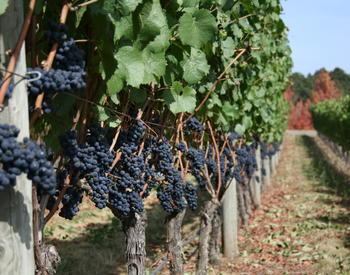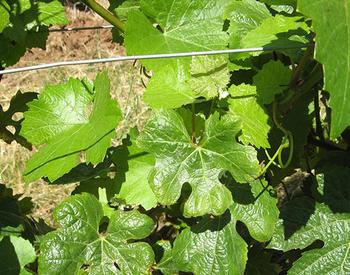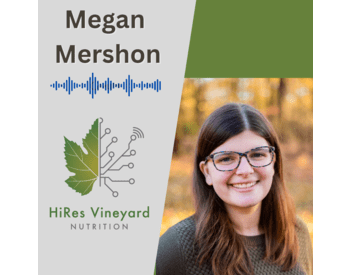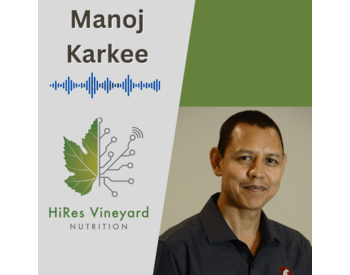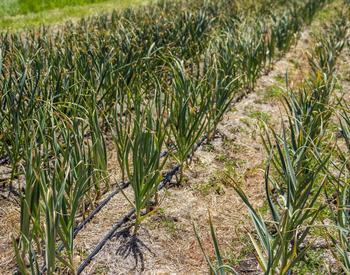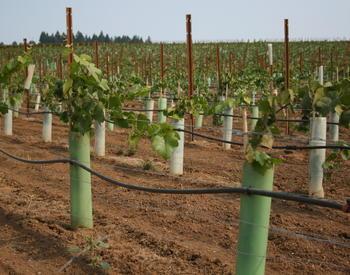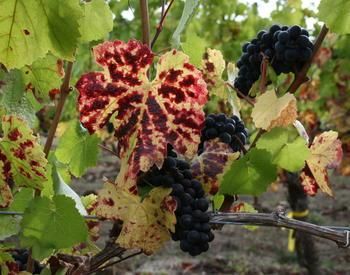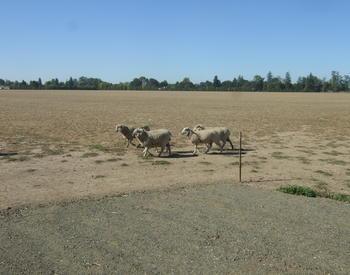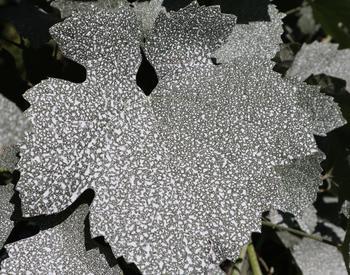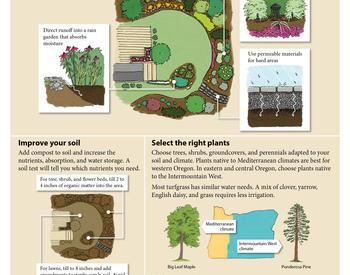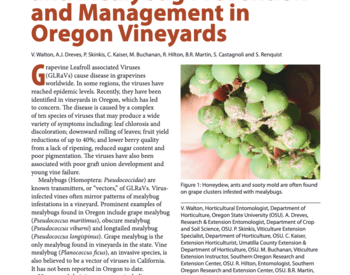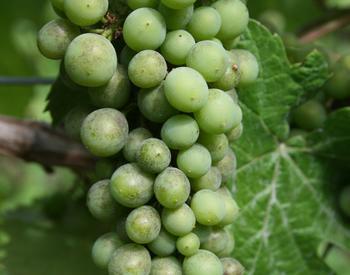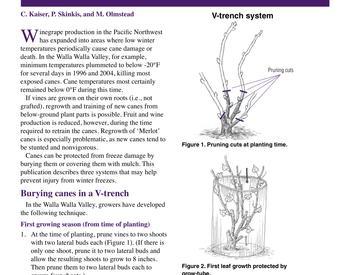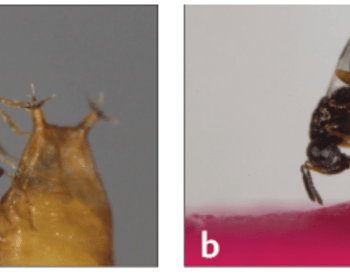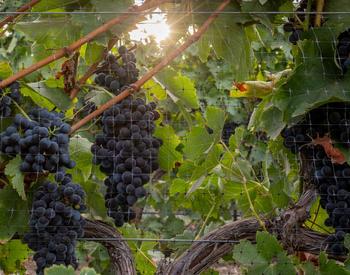Why water management is important
Proper management of grapevine water status is critical to optimizing your vineyard production practices, whether they are focused on yield, fruit quality or both. The water status of vines — how “wet” or “dry” they are — affects all aspects of plant function and depends on two factors:
- The available water supply in the soil.
- The evaporative demand of the atmosphere.
In most years, vineyards in Oregon start the season with a full soil water profile. However, as the season progresses, canopies develop rapidly, fill out the trellis and intercept more solar radiation. In many wine grape growing areas of the state, the evaporative demand of the atmosphere exceeds the amount of the available water stored in the soil, resulting in a soil water deficit that lowers vine water status.
In semi-arid and arid grape growing regions of the state, such as southern and eastern Oregon, vine water status is managed with supplemental irrigation. In temperate regions, such as the Willamette Valley, vine water status can be more difficult to manage, particularly if irrigation is not available onsite.
As the soil profile begins to dry out, the primary question becomes, How can I manage vine water status? Below is a brief review of some steps to take whether your vineyard is equipped with an irrigation system or not.
Irrigation: How much and when?
As for most cultural practices, the two most important questions to answer in irrigation management are How much? and When?
The timing of the first irrigation of the season has traditionally been done by monitoring visual symptoms such as the relationship between the shoot tips and tendrils (Figure 1). The further growth of tendrils beyond the shoot tips indicates that the shoot is growing rapidly and vine is not water-stressed.
This method has some validity due to the fact that plant growth is the most sensitive to a decline in water status (Figure 2). This method can work well if you have been managing the same site for several years, but inherent variability in soils, plants and atmospheric conditions can create difficulties in diagnosing visual symptoms for new managers or at new sites.
Moreover, the phenological state of the vine can be misleading. Shoot growth rate slows down substantially following berry set, as the clusters become the dominant carbon sinks and berries begin growing rapidly. What may look like shoot growth slowing down due to water stress may in fact be a simple result of a change in the vine’s source-sink relations.
Therefore, looking at shoot tips alone can be misleading. To supplement monitoring for visual symptoms, irrigation can be initiated based on one or more of the following methods:
- Water budgeting.
- Soil-based techniques.
- Plant-based techniques.
Water budgeting
Efficient water budgeting requires knowledge of basic vineyard characteristics such as effective vine rooting depth, soil water holding capacity within that rooting depth, and the vineyard water requirement. Vineyard water requirement is a function of the evaporative demand of the site, trellis design, and row spacing. The trellis design and row spacing determine the crop coefficient.
Simply put, as evaporative demand increases, so will the water requirement of the vineyard. Additionally, the vine’s water requirement increases as your vines grow and fill the trellis and more of the vineyard is covered in leaf area.
A water budget accounts for the amount of water in the soil at the beginning of the season and then subtracts water from this value as the vines grow and use more water. This can be done easily with using a spreadsheet if the above-mentioned parameters are known or can be estimated. However, it is advisable to supplement your water budget with field measurements.
Soil- and plant-based measurements
Integrating soil- and plant-based moisture monitoring techniques together with your water budget will allow you to irrigate more efficiently and confidently. Traditional moisture monitoring (your shovel) can work well enough if your soils are fairly deep and uniform with little stratification. However, this is rarely the case, and too few soil observations can lead to misinterpretation and ultimately variable water stress.
Soil moisture probes usually measure one of two kinds of soil water: water tension or water content. Each type has its own benefits and drawbacks.
Soil water tension (SWT) is a measure of how tightly the soil is holding on to water, and by extension how difficult the water is for the vines roots to extract. Measurements of SWT are convenient because the values are transferable across soils (works for many different soil types). Unfortunately, SWT values do not inform one on how much to irrigate.
By contrast, soil water content (SWC) is a measure of the volume of water in the soil and can tell you how much to irrigate. SWC measurements are convenient because you can relate them to your water budget and determine how much to irrigate. However, since different soils can hold and release water differently, the values depend greatly on soil type. Therefore, it is important to calibrate your SWC probes to your own soil. Traditionally, irrigation is initiated when SWC is reduced by half.
Plant-based measurements can be very sensitive and reliable indicators of when to irrigate, but they are also labor intensive. Plant-based measurements of leaf water potential (using a pressure chamber) or stomatal conductance (using a pyrometer) reflect the plant’s experience in a drying soil and atmosphere.
In a way, they can give you a sense of how the plant is “feeling” the water stress. There has been and continues to be substantial research that aims to relate values from these various instruments to aspects of vine yield and quality. Some target values have been established, but little information has been generated specifically for Oregon vineyards.
Water status management without irrigation
It can be difficult to manage plant water status under drying conditions without supplemental irrigation, and the difficulty depends on the region of the state. However, there are a number of cultural practices that could be employed in anticipation of drought.
First, the vineyard floor should be managed such that no additional vegetation is present that can compete with the vines for water. This can be done either mechanically (tillage) or chemically (herbicide)
An older but effective technique of dust mulching can be employed as well. Although most effective in lighter soils, the dust mulch approach involves repeated shallow cultivation and tillage that results in a fluffy, dry layer of top soil that acts as a mulch above the wetter soil below.
The difference in pore size between the undisturbed lower strata and dusty upper layer, water is unable to move through the top soil due to capillary inhibition. In lieu of a dust mulch, a traditional mulch can be top-dressed on the vine berm (undervine, within row).
Strategies such as reducing the total leaf area can be effective in reducing water loss from the vineyard. Vines can be hedged to a lower height, or leaves can be removed by machine or by hand. If leaf area is reduced by hand, lateral shoots could be preferentially removed since they carry leaves that are younger and generally use more water relative to older primary leaves.
Care should be taken when reducing leaf area so as to not overexpose clusters to solar radiation. Moreover, it should be noted that significant reduction in leaf area may slow ripening, so appropriate crop load management should be considered as well.
Finally, there are some anti-transpirant sprays that can reduce water loss from the canopy, but remember that transpiration cools plant tissue and drives photosynthesis, so greatly reducing transpiration may not work.
Integrated water status management
Ultimately, one should employ an integrated approach to irrigation and water management, just as with pest management. Implementing only one kind of management strategy for determining when and how much to irrigate may do the job some of the time, but there will be times when the method is unreliable, and could result in yield and/or quality loss.
Tracking vine growth (crop coefficient) and evaporative demand (ET0) as well as monitoring soil and plant moisture can all be utilized synergistically to effectively and proactively manage plant water status. In this way, a more complete picture of the vineyard’s water conditions will be known and production will be optimized.
Further information
Check out the following OSU Extension resources for more information about plant-based water stress monitoring and irrigation
